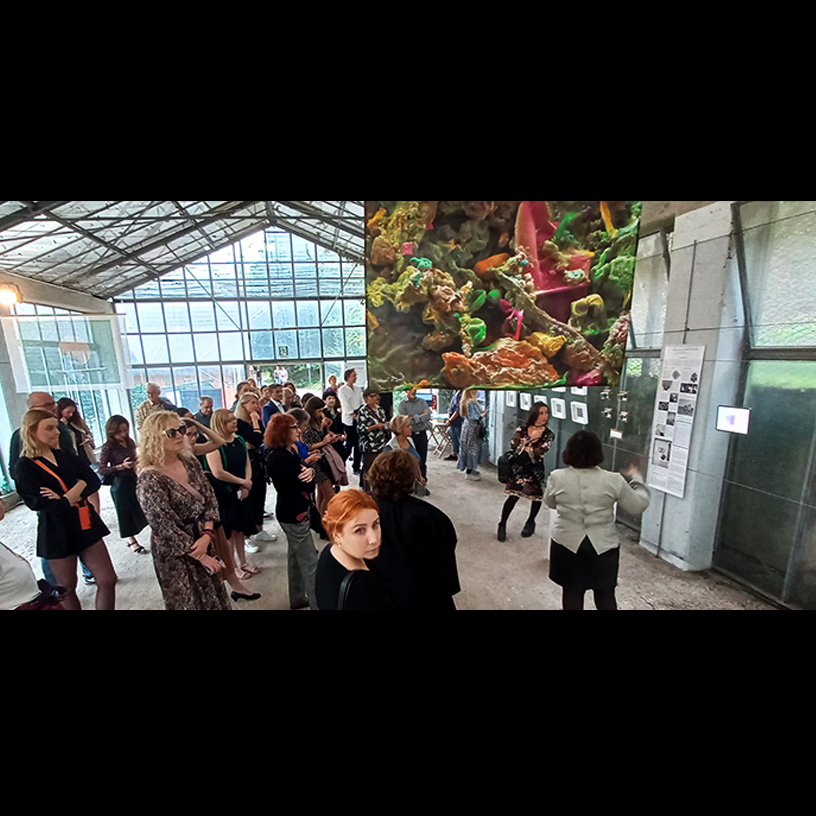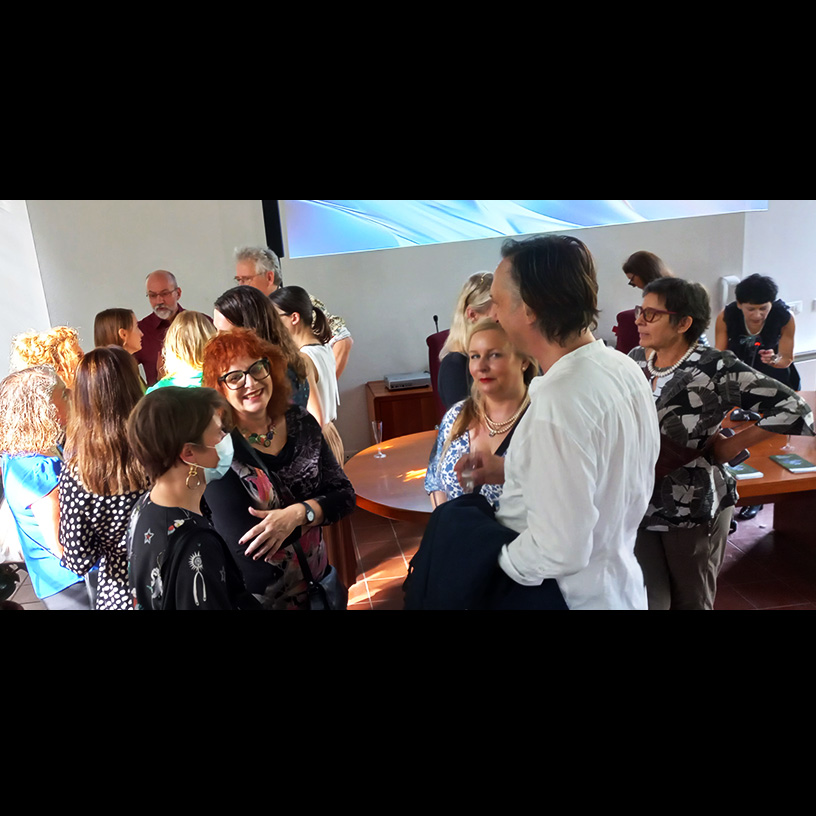METUSHELAH
in collaboration with Olga Kisseleva
Video installation

For those who can perceive the true nature of things, a simple green tree is a greater miracle than a tree of gold or silver.
M. Luther
This unique specimen of palm tree, nicknamed “Methuselah” by Israeli scientists, grew 1500 years after the total extinction of its “brothers”, thanks to the efforts of the biologist E. Solowey. It has sprouted from an ancient palm seed found by the renowned archaeologist Y. Yadin in the ruins of the Masada fortress. In the distant past, these desert lands were home to groves of palm trees. The date palm was one of the “Seven Species” (Hebrew: שבעת המינים , Shiv’at HaMinim) – the most important plants that fed the Israelites for many centuries.
“Methuselah”, the first tree of the future forest of “resurrected” extinct species, has already been revived. In the future – a mere twenty years from now – we will be able to take a walk in such a forest, enjoying the singing of the nesting birds, listening to the rustling of the leaves, and breathing in the old-new fragrance of the legendary fruit of the date palm.
The scientific story of the revival of this extinct tree is fascinating. Nowadays, laboratories are seriously investigating the possibility of growing trees from seeds discovered by archaeologists in Masada. For now, only a few successful experiments have been officially reported. One of these is the attempt by biologist E. Solowey to recreate the ancient date palm. Dr. Elaine Solowey, a member of Kibbutz Ketura and director of the Center for Sustainable Agriculture at the Arava Institute for Environmental Studies, is a pioneer in the field of irrigation engineering and sustainable agriculture in dry regions. For this reason, she was entrusted with a unique experiment – the first of its kind in the world – aimed at recreating a palm tree from the seeds of an ancient date palm that were found in Masada. The Judean date palm used to be known and cherished all over the world, because of the exceptional deliciousness and size of its fruit. It was notable also for its remarkable medicinal properties: the dates were used to treat infections and depression, and consumed as a general restorative that improved overall well-being.
The experiment was carried out with the aid of a specially-developed technology of seed rehydration (constantly replenishing fluids at a fixed temperature), and with the use of fertilizers developed by her for this purpose from algae (this technology is still kept secret). Today, tourists can observe the magnificent, young “Methuselah” tree that has come back to us from the mists of time. E. Solowey is carrying on her work, hoping to harvest the first fruits and plant the first grove of recreated palm trees.
In the “Methuselah” video, Lilia Chak has captured the movement of the leaves of the canopy of the eponymous palm tree. This movement is then projected onto the walls of the exhibition space. In this way, the artist has created an illusory likeness of the lost ancient forest that grew in the territory of present-day Israel millennia ago. Lilia Chak has limited herself to modest, yet xpressive, monochrome, turning the footage into black-and-white graphics.
The interplay of light and shadow in “Methuselah” takes us back to the Biblical verses: “And the earth was without form, and void; and darkness was upon the face of the deep; and the Spirit of God moved upon the face of the waters. And God said: Let there be light. And there was light. And God saw the light that it was good; and God divided the light from the darkness. And God called the light Day, and the darkness he called Night.” Since the dawn of history, the image of light and darkness has held profound philosophical significance in the cultural traditions of various peoples. The opposition between light and dark, white and black – as symbols of good and evil, respectively – has had a lasting impact on the formation of the European worldview.
Inspired by the unique history of the resurrection of “Methuselah”, Lilia Chak is aestheticizing this plant in her video. The palm tree itself possesses great physical beauty. All those who have looked at it have noted its perfect proportions and elegant leaves. While creating her fantastic forest for the “Methuselah” video, the artist uses the image of the shadows cast by the leaves of the legendary tree as a symbol of hope and the rebirth of nature.
Shows:
- – In A Hotter House. Group exhibition. Green House, The Ohio State University, USA. Curators: Doo-sung Yoo, Amy Youngs.
- – Interwoven Scape. Group exhibition. Shenzhen Art Museum, Shenzhen, China, Shenzhen, China. Curator: Qiu Zhijie.
- – Our Bio-Tech Planet. Group exhibition. Museo Orto Botanico organised by Art & Science Node Berlin, Rome, Italy. Curators: Prof. Joanna Hofmann, Dr. Juliet Wallace, Dr. Lara Bruno.
- – EDEN. Group exhibition in collaboration with Prof. Olga Kisseleva. Matsudo International Science Art Festival, Tokyo, Japan.
- – Speculating on the Future through Art and Science. Group exhibition in collaboration with Prof. Olga Kisseleva. BOZAR, Brussels, Belgium.
- – Wonderful World. Group exhibition in collaboration with Prof. Olga Kisseleva. FEFU Art Museum, Vladivostok, Russia. Curator: Julia Klimko.
- – EDEN. Group exhibition in collaboration with Prof. Olga Kisseleva. Ars Electronica, Linz, Austria.
- – Listening to Trees across the Jordan River. Group Exhibition. Negev Museum of Art, Beer-Sheva, Israel. Curator: Dr. Dalia Manor.
Events:
- – Dendro-art. Workshop organised by Bar-Ilan University. Ramat Gan, Israel.
Title of my presentation:Dendro-Art: Tree as an artwork
. - – MANOFIM. International conference organised by Jerusalem Contemporary Art Festival. Jerusalem, Israel.
Title of my presentation:Art, Biology and Ecology
. - – EDEN. Workshop at organised by Sorbonne in collaboration with ITMO University. St. Petersburg, Russia.
Title of my presentation:Dendro-art – classification of projects
. - – The Human to Come. International symposium organised by Le Fresnoy – Studio national des arts contemporains in collaboration with CNRS. Lille, France.
Title of my presentation:Listening To Trees Across The Jordan River
. - – Art and Biology: The Meeting Point. International symposium organised by Negev Museum of Art. Beer-Sheva, Israel.
Title of my presentation:The Sorbonne Art & Science Laboratory as a leader of Dendro-art
. - – Ethical Durable Ecology Nature. International symposium organised by Château de Rentilly – Frac Ile-de France. Paris, France.
Title of my presentation:The Scents of the Ancient World - a Different Reality?
.
Media:
- – Lilia Chak, Olga Kisseleva.
Adopters of Creative Technologies
, article, The Encyclopedia of New Media Art: Volume 2: Artists & Practice (forthcoming 2026). Bloomsbury. London, UK. - – Qiu Zhijie.
Interwoven Scape
, catalogue, page 18. Shenzhen Art Museum. Shenzhen, China. - – Lilia Chak.
Contemporary Practices in Bio-art: When a Tree Becomes an Artwork
, book (ISBN: 1-5275-1949-X; ISBN13: 978-1-5275-1949-7; Pages: 562; Color illustration: 174). Cambridge Scholars Publishing. Cambridge, UK. - – Prof. Ilia Rodov.
Concluding Remarks: Contemplations in the Desert on Nature, Creation, and Art
, article. Negev Museum of Art. Beer-Sheva, Israel. - – Lilia Chak.
Between Art and Science
, brochure for "Listening To Trees Across The Jordan River" exhibition. Negev Museum of Art. Beer-Sheva, Israel.



